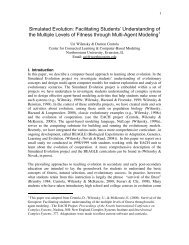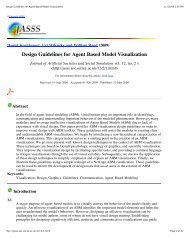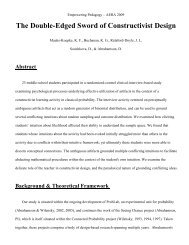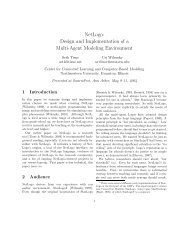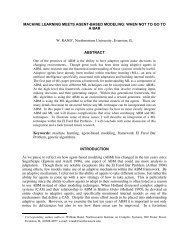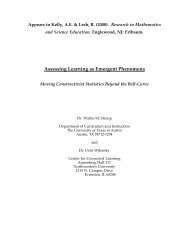Finding Forms of Flocking - The Center for Connected Learning and ...
Finding Forms of Flocking - The Center for Connected Learning and ...
Finding Forms of Flocking - The Center for Connected Learning and ...
Create successful ePaper yourself
Turn your PDF publications into a flip-book with our unique Google optimized e-Paper software.
ut that the results <strong>of</strong> that analysis can tell us something about the model.<br />
Note that the trends we find are unlikely to be global (characterizing the whole<br />
parameter space), but apply only to a local view that is focused on regions <strong>of</strong><br />
the parameter space where the target behavior is expressed mostly strongly.<br />
<strong>The</strong>se results also suggest several important areas <strong>for</strong> future work. First, it is<br />
unclear what circumstances favor the use <strong>of</strong> a genetic algorithm over a simpler<br />
hill climbing search mechanism. Second, the per<strong>for</strong>mance results presented here<br />
may be dependent on any number <strong>of</strong> search algorithm parameters (not to be<br />
confused with model parameters), such as the population size, mutation rate,<br />
crossover rate, elitism, or chromosomal representation. While we attempted to<br />
choose reasonable values <strong>for</strong> these search parameters, it is likely that by tuning<br />
these parameters, the algorithms’ efficiency could be improved. Furthermore,<br />
poorly chosen search parameters could lead to worse per<strong>for</strong>mance than r<strong>and</strong>om<br />
search, <strong>and</strong> should thus be avoided. Also, in future work, we would like to investigate<br />
the use <strong>of</strong> other search algorithms (such as simulated annealing, <strong>and</strong><br />
particle-swarm optimization). Finally, additional consideration should be given<br />
to the treatment <strong>of</strong> model stochasticity <strong>and</strong> noisy objective functions; while running<br />
fewer replicates <strong>of</strong> model runs takes less time <strong>for</strong> searching, large quantities<br />
<strong>of</strong> noise can inhibit search progress. In general, the prospects seem bright <strong>for</strong><br />
using meta-heuristic search, such as genetic algorithms, to improve model exploration<br />
<strong>and</strong> analysis. It is our hope that these promising prospects will encourage<br />
ABM practitioners to flock toward, <strong>and</strong> eventually converge on, new methodologies<br />
<strong>for</strong> model parameter exploration that take advantage <strong>of</strong> these ideas.<br />
Acknowledgments We especially wish to thank William R<strong>and</strong> <strong>for</strong> constructive<br />
feedback on this research, Luis Amaral <strong>for</strong> generously providing computational<br />
resources to carry out our experiments, <strong>and</strong> the National Science Foundation <strong>for</strong><br />
supporting this work (grant IIS-0713619).<br />
References<br />
1. Bankes, S.: Agent-Based Modeling: A Revolution? PNAS 99(10), 7199–7200 (2002)<br />
2. Brueckner, S.A., Parunak, H.V.D.: Resource-aware exploration <strong>of</strong> the emergent<br />
dynamics <strong>of</strong> simulated systems. In: AAMAS ’03: Proceedings <strong>of</strong> the second international<br />
joint conference on Autonomous agents <strong>and</strong> multiagent systems. pp.<br />
781–788. ACM, New York, NY, USA (2003)<br />
3. Bryson, J.J., Ando, Y., Lehmann, H.: Agent-based modelling as scientific method:<br />
a case study analysing primate social behaviour. Philosophical Transactions <strong>of</strong> the<br />
Royal Society B: Biological Sciences 362(1485), 1685–1698 (2007)<br />
4. Calvez, B., Hutzler, G.: Automatic Tuning <strong>of</strong> Agent-Based Models Using Genetic<br />
Algorithms. In: MABS 2005: Proceedings <strong>of</strong> the 6th International Workshop on<br />
Multi-Agent-Based Simulation (2005)<br />
5. Cucker, F., Smale, S.: Emergent behavior in flocks. IEEE Transactions on automatic<br />
control 52(5), 852–862 (2007)<br />
6. Heppner, F., Convissar, J., Moonan Jr, D., Anderson, J.: Visual angle <strong>and</strong> <strong>for</strong>mation<br />
flight in Canada Geese (Branta canadensis). <strong>The</strong> Auk pp. 195–198 (1985)







